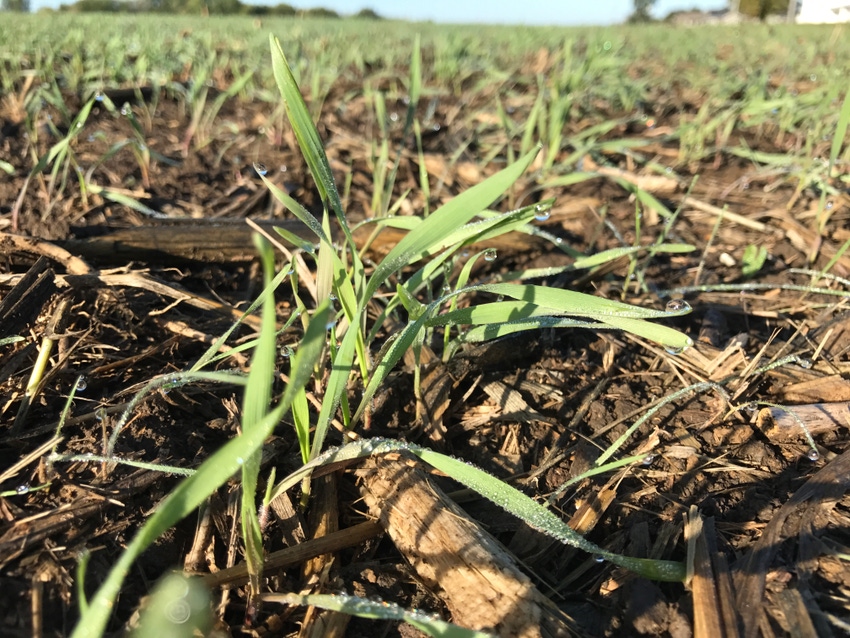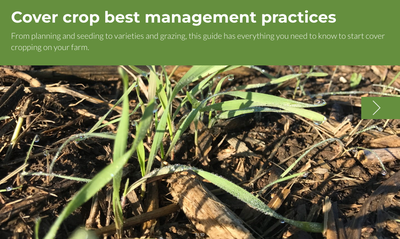July 7, 2022

Whether you’re considering cover crops for soil health or to meet a need as part of a new carbon contract, getting started is no easy task. From planning what to raise on which fields ahead of the next season’s crops, to figure out the best method for planting, they can challenge the best managers. But there's a resource; a cover crop guide.
In the free guide from Farm Progress, readers will find a comprehensive look at how they can be deployed successfully on the farm. This special coverage is available in an easy-to-use digital format that works on your smartphone, tablet or desktop computer. And you can download a PDF version if needed, too.

Download FREE: Cover crop best management practices
The guide has been divided into key sections allowing you to check out the areas you need for your farm. Each section digs in on a specific topic related to raising cover crops.
Why should farms use cover crops?
Farmers across the country are looking at ways to boost soil health, manage crop nutrients and nutrient retention, and perhaps raise more feed for cattle. In each case, cover crops could play a valuable role. The idea of “farming green” isn’t new, with farmers using fall-seeded crops to hold soil in place for some time.
However, the planned use of cover crops can bring key benefits to soil fertility and water conservation. Yet getting started can be a challenge. With good management they can make a difference on the farm. In this section, you’ll find insight into their value including:
Protecting soil from erosion
Moderating soil and air temperature by shading the soil surface.
Preventing soil nutrient loss and increase soil carbon
Cover crops represent an effective in-field practice, and investment account, for the farm by protecting soil, extending the grazing season and reducing the need for stored forages. And they can be grown in any farming system.
Cover crop benefits
The list of benefits is longer than simply adding carbon to soil. In this section there’s a look at how the practice provides added value.
Organic farms have found they can suppress weeds, but it’s a benefit for conventional farms too. With the rise of resistant weeds, producers are finding a healthy fall cover crop can offer weed control in the following year crop.
Cover crops improve water quality. In one study in Michigan researchers found that on average they reduce sediment 1,840 pounds/acre from wind erosion and decrease sediment 340 pounds/acre from water erosion.
Download Cover crop best management practices.
They can also boost fertility in some cases replacing a portion of applied nitrogen to the following crop. The same crop can boost soil microbes, earthworms and other organisms by boosting soil structure. And cover crops can help break up soil compaction.
Farmers using cover crops have seen a yield increase. In Kentucky, winter cover used with no-till planting showed a significant increase in corn yield. Similar results were found at Iowa State University.
Some types, such as tillage radishes, can ��“do the tillage for you” providing improved soil tilth and breaking up soil compaction. They can also facilitate drainage.
Winter cover crops can significantly reduce soil erosion with reductions reaching 50% when winter cover is available. Keeping soil on the farm is an investment in the future of the operation. There’s extensive work showing how impactful they are for reducing erosion.
Some species can be used to help restore storm damaged fields. And for many that’s part of a planned rotation of crops and cover crops that offer an added benefit. Tillage radish has been shown to offer a significant benefit, if it can be worked into the rotation.
Cover crops can also cut your nitrogen cost. In some cases, they can replace nitrogen applications, or at least supplement nitrogen for the crop. Given today’s fertilizer prices, figuring the cost of added nitrogen from cover crops helps pay for the practice.
They can also boost organic matter. Raising OM levels in a field offers other benefits from improved nutrient mineralization, better moisture retention and the opportunity for higher yields.
Using cover crops during drought
There’s a concern that cover crops might not be appropriate in drought conditions, yet these post-crop covers may have added benefits. For example, after the 2012 drought agronomists advised planting them to capture unused nitrogen before it leached below the tile zone.
They can also act as a moisture trap which may counter some who worry that the winter planting might reduce subsoil moisture further. Work in North Dakota has shown them to help conserve moisture, in part because they keep soil covered. Bare soil gives up more moisture than ground protected by a cover crop, researchers found.
Cover cropping plan
What’s the old sayin? Failure to plan is planning to fail. Adding cover crops to your farm’s planting program isn’t done lightly. The key to success is to work through the potential challenges before you engage the first field.
We ask some simple questions to help you determine the best approach to adding cover crops for your farm. From changing crop choices to add a little more fall establishment time to identifying the best fields for cover crop use.
Download our cover crop guide NOW
This section also digs into the questions surrounding cover crop planting choices. A tillage radish may not be right for your farm, but what about annual ryegrass or cereal rye? And what is the difference between those two crops?
There are also “variety mixes” that may be priced lower. They offer both opportunities and challenges. Knowing the mix of seed in a variety cover crop can help you determine the best practices for burndown.
Cover crop guide to varieties
This section pulls together a wide list of cover crop choices available to farmers. While not all are best suited for every operation, this comprehensive guide provides added information about potential uses on the farm.
The list of varieties with a deeper look at their key benefits includes:
Grasses
Annual/Italian ryegrass
Reed Canarygrass
Birdsfoot Trefoil
Kentucky Bluegrass
Forage Chicory
Tall Fescue
Smooth Bromegrass
Barley
Proso Millet
German/Foxtail Millet
Pearl Millet
Oats
Rye/Cereal Rye Grain
Sorghum/Sudangrass
Teff
Triticale
Wheat
Legumes
Alfalfa
Austrian Winter Peas
Crimson Clover
Fava Bean
Berseem Clover
Field Peas
Hairy Vetch
Kura Clover
Medics
Mungbean
Red Clover
Cowpea
Soybean
Velvetbean
Sunn Hemp
Subterranean Clover
Sweet Clover
White Clover
Woollypod Vetch
Brassicas
Black Mustard
Brown Mustard
Spring Mustard
Fall Mustard
Kale
Forage Radish
Arugula
Rapeseed
Turnip
Winter Canola
Non-legume broadleaves
Buckwheat
Flax
Marigolds
How and when to seed cover crops
Just when should you plant cover crops? And how? For many, seeding is becoming the biggest post-harvest activity. And it’s a process that each farmer needs to work out for their specific management approach.
Some farmers turn to air-drills right behind the combine, then turn to aerial-applied seed when time runs short. Others turn to high-clearance applicators that can move through a standing corn crop to apply cover crop seed. The key is timing that planting to get solid emergence before first frost.
Download for FREE: Cover crop best management practices
This section looks at aerial application and its costs, explores how different cover crops get started with fall seeding and provides some tips and insight on best practices for establishing them no matter what planting method has been used.
Establishing a cover crop requires some key practices that can help get the crop established, and in this section there’s even an answer to a key question: What if a cover crop doesn’t germinate?
Grazing and forage options
If you’ve got cattle on the farm, they can be a perfect pairing for a cover crop program, provided you have the right crop. Certain types can be grazed if established in time, and provide an extended grazing season while reducing your need for stored forages.
This section explores the use of winter cover crops for grazing and how best to deploy the practice in your operation. The use of winter cover for early spring grazing is popular in the Southwest, but is gaining popularity farther north as more growers turn to this technique.
Using the practice can help with cattle feed economics too buy saving feed costs, keeping cows cleaner during mud season and you spread manure nutrients with no added fuel or labor.
There’s also a discussion of fall-grazing covers and how best to use that practice.
How to terminate cover crops
This section of the cover crop guide deals with one of the more challenging issues for farmers on their first time – terminating them to make room for the spring crop. There are different ways to approach termination from the timing to the approach (chemical or mechanical), which can impact your farm.
There’s a discussion of how herbicide carryover impacts your plan, which can be challenged since cover crops aren’t usually listed on many herbicide labels.
And there are termination tips to maximize your approach to clearing covers for the new-season crops.
Calculating almond orchard crops
Cover crops aren’t just for corn, soybeans and cotton fields. Orchards are finding new ways to protect soil between the trees and boost soil health too. This section digs in on the practice offering insight for this key orchard crop, but also provides help for farmers with orchards of other types from applies to cherries.
A healthy cover crop in an orchard can offer improved soil health and structure, boost fertility and reduce erosion. While many almond orchards moved away from cover crops, many are returning to the practice, which can also help reduce the need for herbicides.
Download the cover crop guide: Cover crop best management practices
About the Author(s)
You May Also Like






